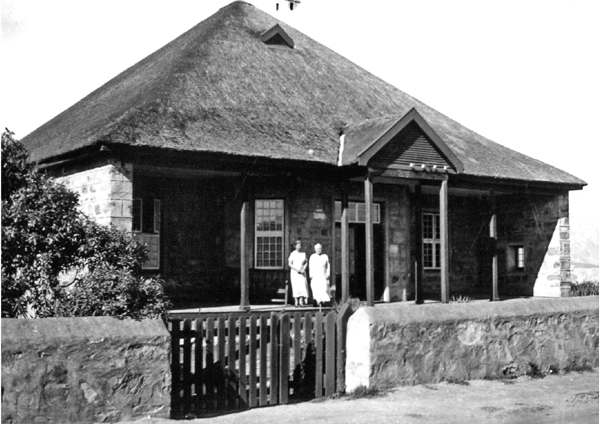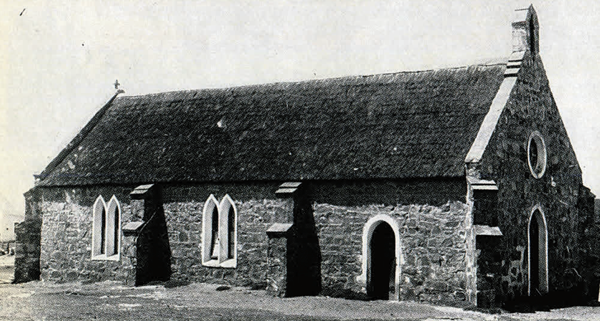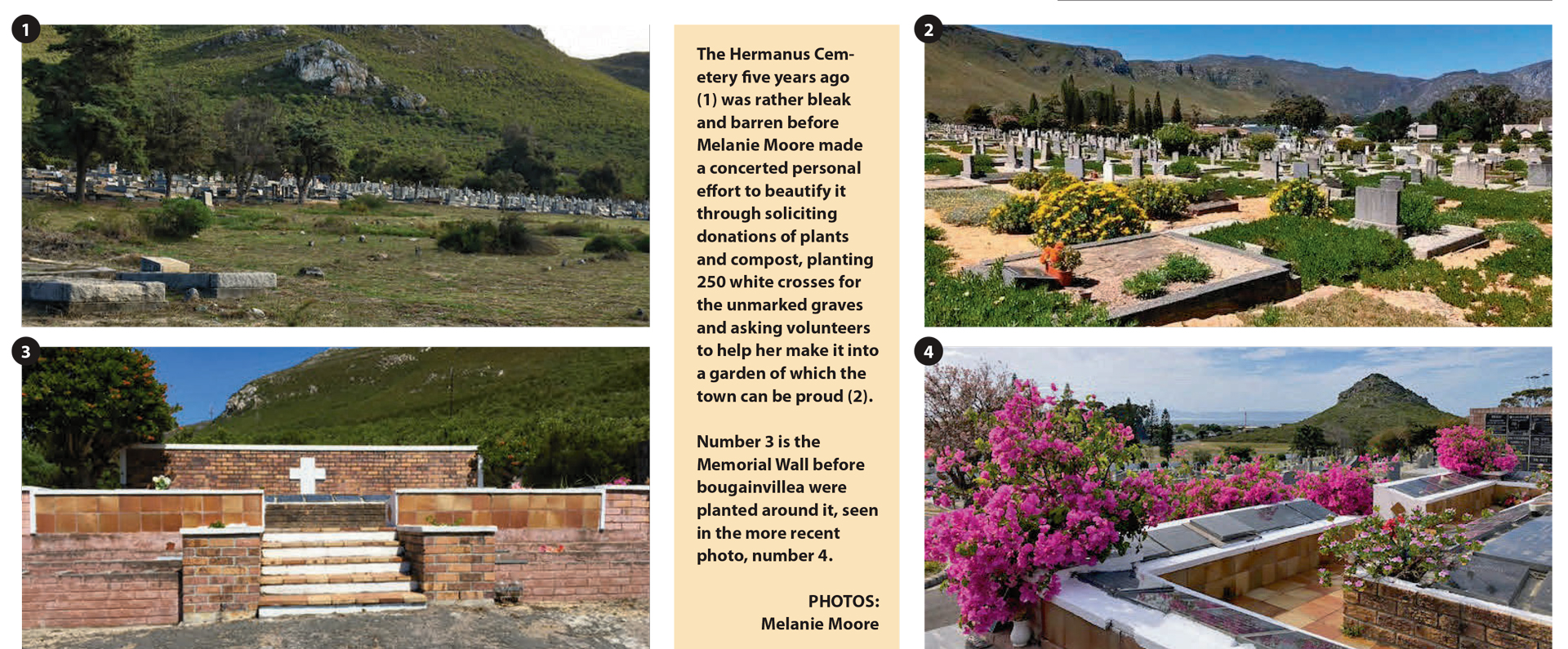
DESTINATION HERMANUS (third Instalment)
November 17, 2021
Destination Hermanus – a journey in history
January 19, 2022Writer
Robin Lee, Hermanus History Society
We have several words in English to refer to places where we bury our dead: burying ground, burial place, graveyard, churchyard and cemetery, for example. In the history of Hermanus, different terms have been used at different times.
It also appears that different places have been used as cemeteries at different times. The earliest two recorded were inside what we would now see as the central business district.
Alex Luyt, a second-generation resident of the town, identified these two sites in a talk he gave in the 1950s, as reported in an early issue of the Hermanus News. He stated that the ‘European’ cemetery was located in the late 19th century near St Peter’s School and Church, probably including the present open area next to St Peter’s Parish Hall and facing onto Marine Drive. The ‘non-European’ cemetery was located on the cliffs to the southwest of The Marine Hotel.
However, as early as 1898, burials were taking place at the present cemetery site, which was described as ‘behind the koppie’ – the present Hoy’s Koppie. In the mid-1930s, the Municipality decided to declare a formal cemetery at the current site. In 1938, the remains from the European site were exhumed and re-interred in the present cemetery at a special ceremony. While the re-interment took place in a demarcated area, there were no details recorded regarding individual names. From 1938, all burials from the town were made at the present cemetery.
When the Hermanus Municipal Cemetery was created, cemeteries were assumed to be best if inconspicuous and located at some distance from the town’s day-to-day life. It was believed that families would maintain and even beautify relatives’ graves, and the local authority did not foresee any responsibilities beyond occasional cleaning up of the general area. The beautification of the cemetery as a municipal asset was not thought of at all.
However, some changes have taken place in the late 20th and 21st centuries. The central business districts and residential areas of towns have grown and are now much closer to the cemeteries. In many cases, families have moved away from the town and no longer have the interest or capacity to maintain family graves.
Thirdly, residents and visitors have become interested in the history of individuals and families whose members are buried in the cemeteries and visits to cemeteries for purposes of memorialising or studying graves have increased.
These changes mean that the local government and individuals are becoming involved in the maintenance and even ‘improvement’ of cemeteries. In Hermanus, Melanie Moore started an initiative to ‘beautify’ the municipal cemetery. After some initial hesitation, the Municipality has supported her enterprise, and in October 2021, the Hermanus History Society threw its weight behind this initiative.
The History Society is interested in many notable people from Hermanus buried there or whose ashes are included in the wall of remembrance. Included are the mayor and freeman of the town Meester W H Paterson, P John Luyt, owner of The Marine and Riviera hotels, the Luyts’ son Henry, David Esau Allen, owner of the Windsor Hotel, and the novelist Stuart Cloete and his wife, Mildred.
In the recorded history of Hermanus, there are several descriptions of funerals in the present cemetery. In her memoirs, Joey van Rhyn Luyt describes the funeral of her husband in 1940:
On the day of the funeral, 20 January, all shops and businesses in Hermanus closed for the afternoon, and all flags hung at halfmast. Three lorries, piled high with wreaths, followed the hearse. The service was held at St Peter’s Church, which was packed with people and the grounds crowded with those who could not get in. The funeral procession was so long that cars were still leaving the Church when the hearse had already reached the cemetery, and we had to wait while the people assembled.
The grave had been lined with artificial grass mats to hide the raw earth, but this was not good enough for George Henn. He had spent the morning stapling flowers onto the mats so that the grave was entirely filled with blossoms.
Melanie Moore welcomes help and involvement from interested individuals. She can be contacted at melanie.ronell.moore@ gmail.com. These are some of her ideas:
- Spread the word about the cemetery upgrading programme and get your community involved
- Everybody with family graves, please tend to them
- Give your time – it is just a big garden that needs weeding, cleaning, planting, watering etc.
- Donate – compost, plants, trees etc.
- Give financial help
- Be creative: Start a historical walk through the cemetery. Mark the important graves. Write about the historical figures buried there. Draw a map of the walk and leave a pamphlet at the tourism office
Bleak cemetery now a beautiful garden
The Hermanus Cemetery has come a long way in the past five years, since 2017. From a rather overgrown, bleak and barren public space in the heart of the town to a cleaner, greener and more welcoming environment.
It has been transformed with waterwise plants, 46 trees and 250 striking white crosses thanks to the dedicated campaigning, hard work and fundraising by resident Melanie Moore. As Melanie is now leaving Hermanus, she is looking for a successor to keep her much-valued work alive from the beginning of March 2022.
With the help of volunteers, donations (plants, trees, compost, cash) and the vital physical help of assistant Gibson Kadango, Melanie and her crew have turned the cemetery into a garden. This is now a space the local community can come to visit, which they can be proud of and show off to visitors. It is a garden that leaves a good feeling among the Hermanus community.
“I thank everybody who helped me during the past five years,” says Melanie. “This includes all the individuals, the nurseries (Walker Bay, Fynbos, Super Plants), the schools, the Overstrand Municipality, our councillor Kari Brice and the silent friend who helped me pay Gibson to work three times a week in the cemetery.
“It is wonderful to see the cemetery ‘bloom’ and become one with the surrounding buildings and inner town.
Highlights for me during these five years were getting volunteers and schools involved and finding teachers with creative minds and willingness to conduct amazing projects with the cemetery in mind. It has been very special to see the children enjoy the space and also to see how we have made a difference to the people visiting the cemetery. More people come for walks now and I am often told by visitors that they feel much safer in the area and are happy to see a well-kept cemetery.”
Melanie admits she is sad to let go of this retirement project, saying: “I regret not being able to celebrate the special annual days like Mandela Day when the public gave 67 minutes of their time to help in the cemetery; Spring Day when we got together to plant succulents and do some weeding; Remembrance Day when we decorated the crosses with red poppies, followed by a pigeon flight and the sounds of the Last Post, remembering those who went before us.
“The upgrading of the cemetery was definitely worthwhile. It was a privilege to use my energy in a positive way.”
Melanie certainly leaves a wonderful legacy and has set a great example for another member/s of the public to step into her shoes. Anyone interested in leading this campaign can contact Melanie on 071 239 6646 or email melanie.ronell.moore@gmail.
- Sarah Taylor


